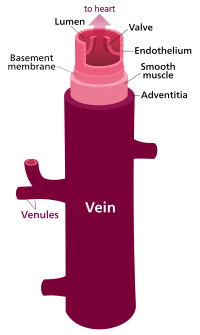
Photo from wikipedia
Chronic venous disease (CVD) is a progressive inflammatory disease that increases in prevalence with age. Elucidating the underlying molecular mechanism of CVD development is essential for disease prevention and treatment.… Click to show full abstract
Chronic venous disease (CVD) is a progressive inflammatory disease that increases in prevalence with age. Elucidating the underlying molecular mechanism of CVD development is essential for disease prevention and treatment. This study constructed a mouse model of iliac vein stenosis to explore the mechanism of the CVD disease progression, and diosmin was administered as a positive control (as recommended by clinical practice). The mouse model was established successfully with iliac vein stenosis, leading to the expansion of the intercellular space and venous leakage. Conversely, micronized diosmin showed a dose-dependent therapeutic effect for these manifestations. Concerning the mechanism, iliac vein stenosis caused an inflammatory response in veins, while diosmin suppressed this increase. Furthermore, RNA sequencing analysis indicated that diosmin significantly improved muscle function through actin filament organization and muscle contraction. These results indicated that the mouse model of iliac vein stenosis is a reliable model to study venous diseases. Furthermore, the dose-dependent therapeutic effect of diosmin on stenosis (without toxic side-effects) suggests greater protection against venous diseases at higher doses of diosmin.
Journal Title: Frontiers in Cardiovascular Medicine
Year Published: 2022
Link to full text (if available)
Share on Social Media: Sign Up to like & get
recommendations!